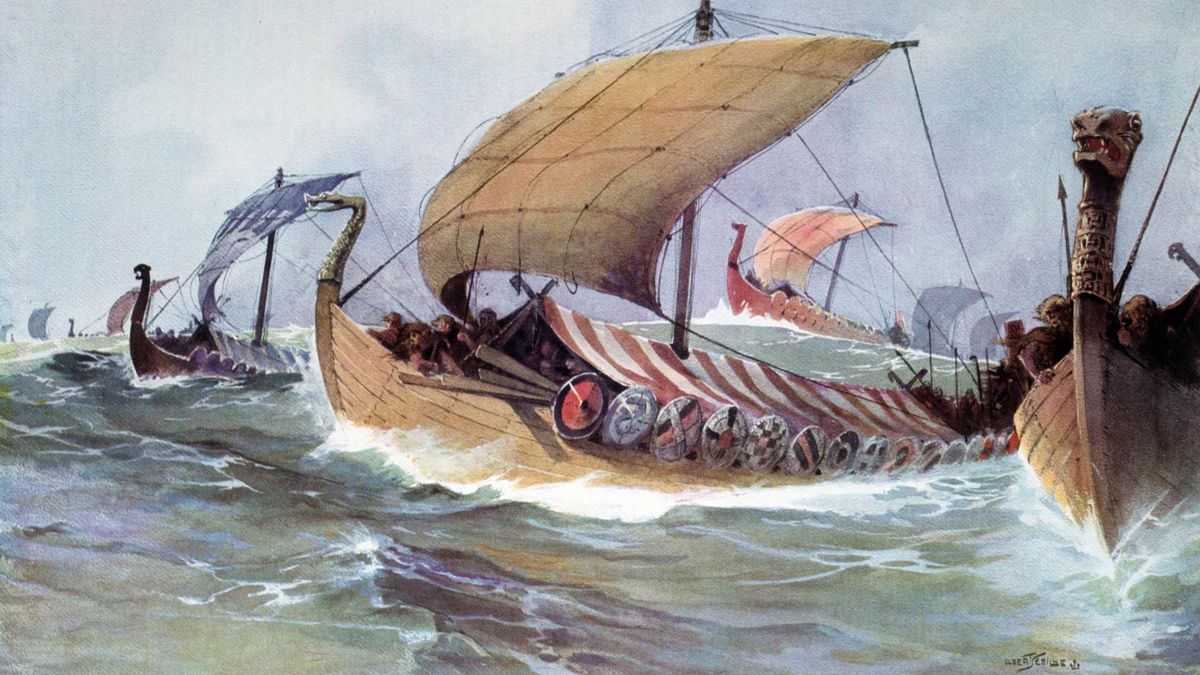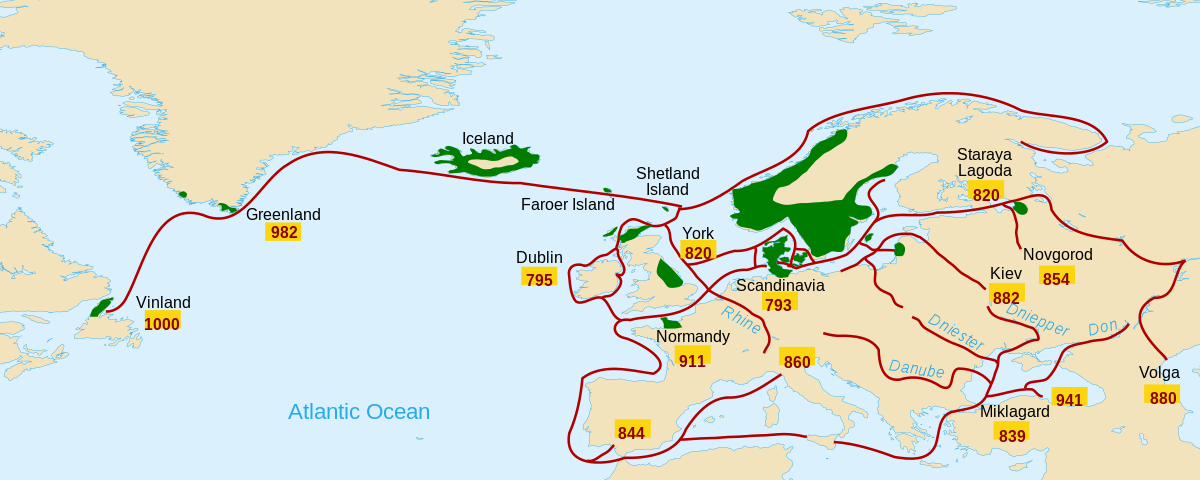Introduction to the Vikings: History, Culture, and Legacy

The Vikings, that we often associate as seafaring warriors, raiders and traders, and global explorers, left an indelible mark on the world during the Viking Age, spanning roughly from the late 8th century to the early 11th century. Originating from what is now Denmark, Norway, and Sweden, the Vikings ventured far beyond their homeland, reaching as far as North America, the Mediterranean, and Central Asia. Their influence is evident in the numerous archaeological findings, historical texts, and lasting cultural impacts.
Origins and Society
The term “Viking” is derived from the Old Norse word “víkingr,” meaning pirate or raider. However, not all Norse people were Vikings; the term specifically refers to those who took part in overseas expeditions. The Viking Age is commonly marked by the raid on the Lindisfarne monastery in 793 AD, which heralded the beginning of a period characterized by maritime expansion, trade, and warfare.
Viking society was complex and multifaceted. It was structured around a chieftain-based system, with power consolidated in the hands of local leaders who ruled over small communities. These chieftains were often warrior leaders who maintained their status through both martial prowess and wealth acquired through raids and trade. Social classes included the noble jarls, free farmers known as karls, and thralls, who were enslaved individuals captured during raids.
Exploration and Expansion
The Vikings are renowned for their remarkable seafaring abilities, which allowed them to travel vast distances in their longships. These vessels were ingeniously designed for both ocean voyages and river navigation, featuring shallow drafts that enabled beach landings and inland travel.
Their expansion was driven by a combination of factors including overpopulation, political instability, and the lure of wealth and new territories. Vikings established settlements in the British Isles, Iceland, Greenland, and briefly in North America at a site known as Vinland, identified with the Norse site at L’Anse aux Meadows in Newfoundland, Canada.

Trade and Economy
While the Vikings are often remembered for their raids, they were also skilled traders. They established extensive trade networks that connected the Scandinavian world with Europe, the Byzantine Empire, and the Abbasid Caliphate. Key trade goods included furs, slaves, walrus ivory, and amber, while they imported silver, silk, spices, and other luxury items.
The town of Birka in Sweden, Hedeby in Denmark (now located in modern day Germany), and Kaupang in Norway were significant trade centers that facilitated this exchange of goods and culture. These trading hubs were bustling markets where not only goods but also ideas and technologies were exchanged.
Culture and Society
Religion and Mythology
Viking culture was deeply influenced by Norse mythology, which played a central role in their spiritual and daily lives. Their pantheon included gods like Odin, the all-father and god of war and wisdom; Thor, the thunder god and protector of mankind; and Freyja, the goddess of love and fertility. These deities were not only worshipped but were also integral to their understanding of the world and their place within it.
Rituals and sacrifices, known as blóts, were a significant aspect of Viking religious practice. These could be small, private offerings or large communal festivals. Important sites such as Uppsala in Sweden served as major centers of worship and ritual activity.

Art and Literature
Viking art, known as Norse or Scandinavian art, is characterized by intricate designs and motifs, often featuring interlacing patterns, animal figures, and mythical creatures. These designs were prevalent in various mediums, including wood carvings, metalwork, and textiles. The Oseberg ship, a well-preserved Viking burial ship, is a prime example of the elaborate artistry of the period, showcasing detailed carvings and craftsmanship.
Literature in the Viking Age primarily consisted of oral tradition, later recorded in the sagas and eddas. The Poetic Edda and the Prose Edda are collections of mythological and heroic poems that provide insight into Norse beliefs and legends. These texts, written down in the 13th century, remain crucial sources for understanding Viking culture and mythology.
Daily Life and Social Structure
Viking daily life varied depending on one’s social status and occupation. The majority of the population were farmers who cultivated crops such as barley, oats, and rye, and raised livestock including cattle, sheep, and pigs. Fishing and hunting also supplemented their diet.
Viking households were typically extended families living in longhouses, large wooden structures that housed both people and animals. These buildings were often the center of social life, where families gathered, worked, and told stories by the fire.
Gender roles in Viking society were more fluid than in many contemporary cultures. Women could own property, request a divorce, and manage farms and businesses in their husbands’ absence. Notable female figures, such as the legendary shieldmaidens, were warriors who fought alongside men, although the historical accuracy of these accounts is still debated.
Clothing and Appearance
Viking clothing was practical, designed to withstand the harsh Scandinavian climate. Men typically wore tunics and trousers, while women wore long dresses with aprons. Both men and women wore cloaks fastened with brooches for added warmth. Wool, linen, and animal skins were the primary materials used in their garments.
Personal grooming was also important to the Vikings. Combs, tweezers, and ear spoons have been found in archaeological sites, indicating a concern for cleanliness and appearance. Hairstyles varied, with both men and women often braiding their hair. Men might wear beards, which were sometimes elaborately groomed.

Legacy
The Viking legacy is evident in various aspects of modern culture, from language and place names to genetic heritage. For example, many English words such as “sky,” “knife,” and “window” are derived from Old Norse. Additionally, regions such as Normandy in France and cities like Dublin in Ireland have names and histories that reflect their Viking past.
The impact of the Vikings on European history is profound. They not only contributed to the cultural and genetic fabric of the regions they settled in but also played a crucial role in shaping the political landscape of medieval Europe. The establishment of the Duchy of Normandy, for instance, and the subsequent Norman Conquest of England in 1066, were direct results of Viking influence.
References:
- Winroth, A. (2014). The Age of the Vikings. Princeton University Press.
- Brink, S. (2008). The Viking World. Routledge.
- Fitzhugh, W. W., & Ward, E. I. (Eds.). (2000). Vikings: The North Atlantic Saga. Smithsonian Institution Press.
- Jesch, J. (2001). Women in the Viking Age. Boydell Press.
- Larrington, C. (2014). The Poetic Edda. Oxford University Press.
- Haywood, J. (2016). Northmen: The Viking Saga AD 793-1241. St. Martin’s Press.
- Graham-Campbell, J. (2013). Viking Art. Thames & Hudson.
- Kershaw, J. (2009). Viking Identities: Scandinavian Jewellery in England. Oxford University Press.

Comments
This post currently has no comments.